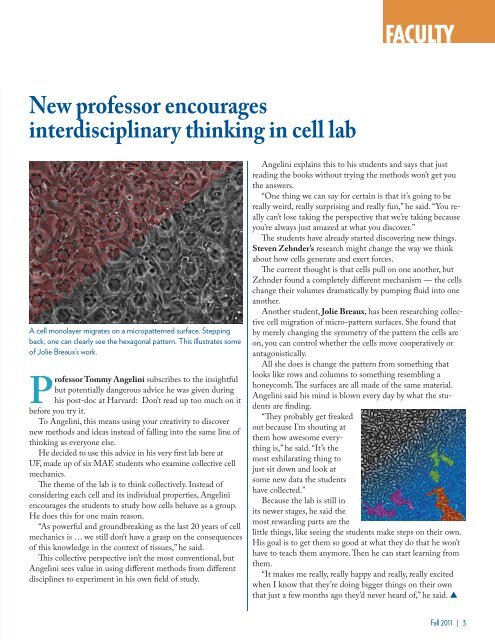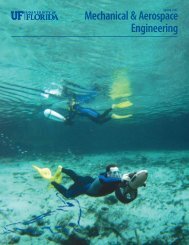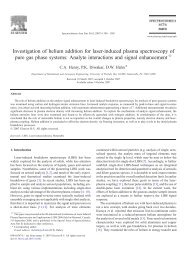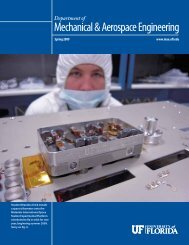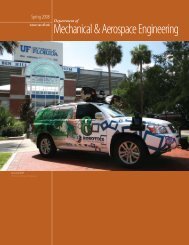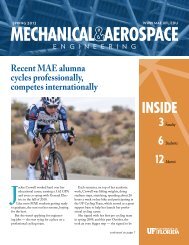here - Department of Mechanical and Aerospace Engineering ...
here - Department of Mechanical and Aerospace Engineering ...
here - Department of Mechanical and Aerospace Engineering ...
- No tags were found...
You also want an ePaper? Increase the reach of your titles
YUMPU automatically turns print PDFs into web optimized ePapers that Google loves.
FACULTY<br />
New pr<strong>of</strong>essor encourages<br />
interdisciplinary thinking in cell lab<br />
A cell monolayer migrates on a micropatterned surface. Stepping<br />
back, one can clearly see the hexagonal pattern. This illustrates some<br />
<strong>of</strong> Jolie Breaux’s work.<br />
Pr<strong>of</strong>essor Tommy Angelini subscribes to the insightful<br />
but potentially dangerous advice he was given during<br />
his post-doc at Harvard: Don’t read up too much on it<br />
before you try it.<br />
To Angelini, this means using your creativity to discover<br />
new methods <strong>and</strong> ideas instead <strong>of</strong> falling into the same line <strong>of</strong><br />
thinking as everyone else.<br />
He decided to use this advice in his very first lab <strong>here</strong> at<br />
UF, made up <strong>of</strong> six MAE students who examine collective cell<br />
mechanics.<br />
The theme <strong>of</strong> the lab is to think collectively. Instead <strong>of</strong><br />
considering each cell <strong>and</strong> its individual properties, Angelini<br />
encourages the students to study how cells behave as a group.<br />
He does this for one main reason.<br />
“As powerful <strong>and</strong> groundbreaking as the last 20 years <strong>of</strong> cell<br />
mechanics is … we still don’t have a grasp on the consequences<br />
<strong>of</strong> this knowledge in the context <strong>of</strong> tissues,” he said.<br />
This collective perspective isn’t the most conventional, but<br />
Angelini sees value in using different methods from different<br />
disciplines to experiment in his own field <strong>of</strong> study.<br />
Angelini explains this to his students <strong>and</strong> says that just<br />
reading the books without trying the methods won’t get you<br />
the answers.<br />
“One thing we can say for certain is that it’s going to be<br />
really weird, really surprising <strong>and</strong> really fun,” he said. “You really<br />
can’t lose taking the perspective that we’re taking because<br />
you’re always just amazed at what you discover.”<br />
The students have already started discovering new things.<br />
Steven Zehnder’s research might change the way we think<br />
about how cells generate <strong>and</strong> exert forces.<br />
The current thought is that cells pull on one another, but<br />
Zehnder found a completely different mechanism — the cells<br />
change their volumes dramatically by pumping fluid into one<br />
another.<br />
Another student, Jolie Breaux, has been researching collective<br />
cell migration <strong>of</strong> micro-pattern surfaces. She found that<br />
by merely changing the symmetry <strong>of</strong> the pattern the cells are<br />
on, you can control whether the cells move cooperatively or<br />
antagonistically.<br />
All she does is change the pattern from something that<br />
looks like rows <strong>and</strong> columns to something resembling a<br />
honeycomb. The surfaces are all made <strong>of</strong> the same material.<br />
Angelini said his mind is blown every day by what the students<br />
are finding.<br />
“They probably get freaked<br />
out because I’m shouting at<br />
them how awesome everything<br />
is,” he said. “It’s the<br />
most exhilarating thing to<br />
just sit down <strong>and</strong> look at<br />
some new data the students<br />
have collected.”<br />
Because the lab is still in<br />
its newer stages, he said the<br />
most rewarding parts are the<br />
little things, like seeing the students make steps on their own.<br />
His goal is to get them so good at what they do that he won’t<br />
have to teach them anymore. Then he can start learning from<br />
them.<br />
“It makes me really, really happy <strong>and</strong> really, really excited<br />
when I know that they’re doing bigger things on their own<br />
that just a few months ago they’d never heard <strong>of</strong>,” he said. p<br />
Fall 2011 | 3


